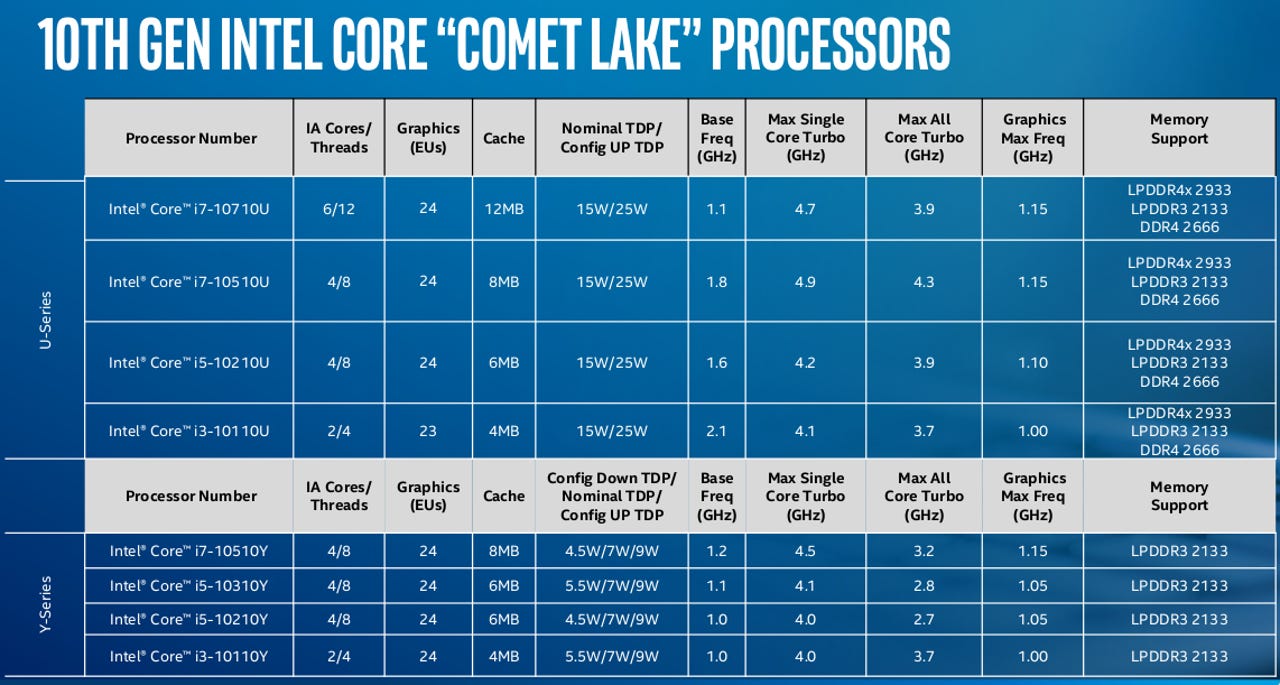Intel releases 10th generation 14nm mobile U and Y chips dubbed Comet Lake


For better or worse, Intel has decided to throw the 10th generation label at its new set of Comet Lake low power U and Y chips, which are built on the older Skylake 14nm manufacturing process.
In all, Intel has unveiled eight new chips, with four in each of the U and Y series.
The U series tops out with the 6-core, 12-thread i7-10710U with a 1.1GHz base frequency, 4.7GHz single core turbo frequency, and 12MB cache, and goes down to the 2-core i3-10110U with a 2.1GHz base frequency, 3.7GHz single core turbo frequency, and 4MB cache.
See also: Apple will end up doing what Intel could not
All U series Comet Lake chips draw down a nominal 15 watts and are capable of now using DDR4 2666 and LPDDR4x 2933 memory, alongside LPDDR3 2133 sticks.
The new Y series chips can only use LPDRR3 2133 memory, and have base frequency ranges between 1GHz and 1.2 GHz, and turbo frequencies between 2.7GHz and 3.2Ghz. The Y series chips have a nominal power rating of 7 watts.
Both the U and Y series chips have 24 execution units for graphics.
Compared to its 8th generation chips, Intel said Comet Lake had up to 16% better performance.
Dell also announced it was releasing a new XPS 13 Developer Edition using Comet Lake chips, which will arrive on September 5.
Earlier this month, Intel launched 11 new Ice Lake mobile chips designed for laptops and 2-in-1 devices that were also broken up into the U and Y series.
The chip giant is now in a position where it has a 10nm Ice Lake 4-core i5-1035G4 with 6MB of cache, a base frequency of 1.1GHz with a maximum turbo frequency of 3.7GHz sitting alongside a 14nm Comet Lake 4-core i5-10210U with 6MB of cache, a 1.6GHz base frequency that is capable of 4.2GHz turbo boost.
Good luck explaining that product lineup to the layperson.
Related Coverage
- Intel, IBM, Google, Microsoft & others join new security-focused industry group
- Intel integrates new FPGA into HPE servers for computing-intensive markets
- Lenovo, Intel ramp up HPC, AI partnership
- Intel takes wraps off 11 new Ice Lake mobile PC chips
- Open source POWER ISA takes aim at Intel and Arm for accelerator-driven computing (TechRepublic)